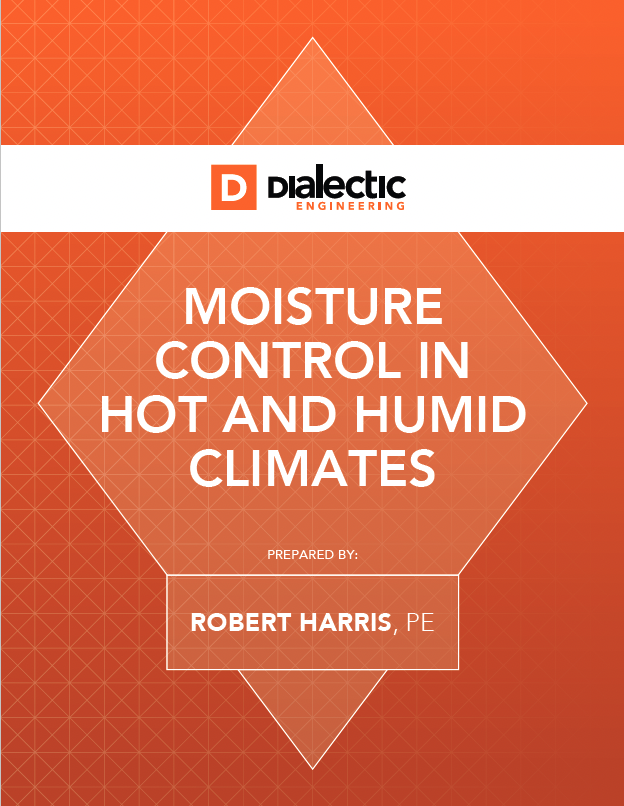
What's Inside?
- Why is Moisture Control Important?
- How Do You Control Moisture in Buildings?
- Best Practices for Moisture Control in Buildings
- Conclusions
Have you ever walked into a room and determined almost instantly that it was uncomfortable? Sticky? Stuffy?
Or worse, does it smell musty or mildewy? Or even worse, do you see mold growing on the walls?
These are all signs of failure to control moisture and humidity in the building.
preventing mold and improving comfort
Beyond environmental comfort complaints, moisture control problems can create conditions that are favorable for mold growth. Remediation costs for removing mold from buildings can be very high, requiring extensive deep cleaning and replacement of building materials such as sheet rock and interior finishes. In some cases, the mold gets so bad that complete remediation is impossible.
In this paper, we will review the causes of moisture control problems in buildings in hot and humid climates, discuss best practices for design and propose some simple and effective solutions to help our clients create environments that are both comfortable and free of mold and other unwanted uncontrolled moisture
driven hazards.
Want commercial insights? Check out our blog:
WHY IS moisture control IMPORTANT?
According to a U.S. Environmental Protection Agency (EPA) study of buildings in the United States, 85% of buildings have been damaged by water at some time, and 45% had active leaks at the time when the data was collected.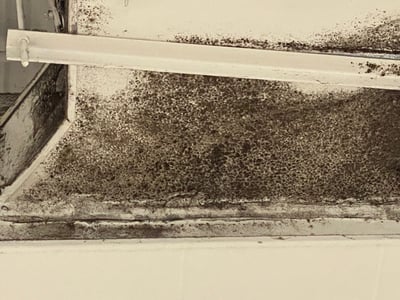
Moisture Damage: Moisture problems can cause issues with building materials and interior finishes, and, in severe cases, can impact the structural integrity of the building.
Impacts Employee Productivity and Health: Moisture control also has a very large impact on thermal comfort in buildings, and failure to maintain comfortable conditions can cause customer and employee complaints, reduced productivity and unhealthy conditions that can include mold and mildew growth.
Expensive Remediation: In addition to health concerns, mold and mildew are extremely costly to remediate in buildings, sometimes requiring removal and replacement of structure, sheet rock and interior finishes.
What are the impacts of mold?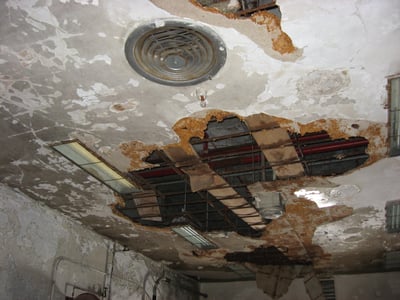
There are many conditions that could lead to mold growth in the interior of a building. These include, but are not limited to, water infiltration from the exterior (building roof or wall leaks), high humidity in the space and moisture condensation inside the space.
Mold requires water, food and oxygen to grow and can propagate quickly in spaces where mold growth conditions exist. Any organic matter, including clothing, leather and paper can serve as a food source for mold.
Human exposure to mold spores may cause allergic symptoms including watering eyes, runny nose, coughing, wheezing, itching, and for some, difficulty breathing, headaches and fatigue.
HOW DO YOU CONTROL MOISTURE IN BUILDINGS?
The first step to controlling moisture in buildings is to ensure that the building has a watertight building envelope and appropriate drainage paths. Roof leaks, wall leaks, window and door openings and other building penetrations can allow water and moist air to enter the building.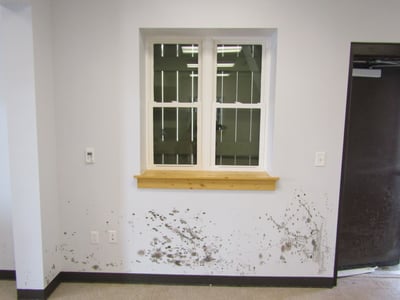
WALLS
Since no building envelope is completely watertight, walls should be designed with clear drainage planes or moisture control layers that provide a pathway for any moisture that gets into the wall assembly to get out.
ROOFING
Roof drainage and gutter systems should direct water away from the building. Roofing should be inspected periodically to ensure that it is in good condition and free of leaks, especially at roof penetrations. Site design should ensure that rainwater flows away from the building.
HVAC
Since moisture can also enter the building through both infiltration and code required ventilation air, the HVAC systems play a major role in moisture control. Properly-sized HVAC systems serve to remove the excess moisture that is being introduced into the building.
As moist air passes through the cooling coil, moisture condenses on the surface of the cooling coil and drips into a drain pan where it is carried out of the building. But improperly designed HVAC systems can fail to achieve the required dehumidification.
For example, oversized cooling systems can cause the unit to “short-cycle,” meaning the system meets the space cooling load so quickly that the moisture in the air fails to condense on the cooling coil and thus is not removed from the space.
Condensate Lines
Clogged HVAC system condensate drain lines can can overflow drain pans, causing damage to walls, ceilings and interior finishes. Condensate lines should be inspected to ensure they are free of clogs.
Air Damper Actuator
Improperly operating HVAC systems can make moisture problems even worse. Something as simple as a broken outside air damper actuator linkage can allow too much uncontrolled moisture-laden outside air to enter the building through the HVAC system.
Plumbing
Plumbing system leaks can also quickly cause damage and create conditions suitable for mold and mildew growth. When plumbing system leaks are detected, they should be addressed immediately.
SUBSCRIBE FOR MORE
BEST PRACTICES FOR MOISTURE CONTROL IN BUILDINGS
Positive Pressure Inside the Building
Maintain positive pressure inside the building. Building mechanical codes prescribe ventilation air rates for various space types, and as long as the mechanical design adheres to these code requirements, there is a
good chance that the building will be positively pressurized.
When humid infiltration air enters the building, it can bring a lot of uncontrolled moisture into the building. Positive building pressurization helps to control unwanted and uncontrolled infiltration air from entering the building.
Even in buildings where positive pressure is correctly maintained, wind combined with the building orientation can impact infiltration, especially in locations where doors are often opening for occupant ingress and egress.
Vestibules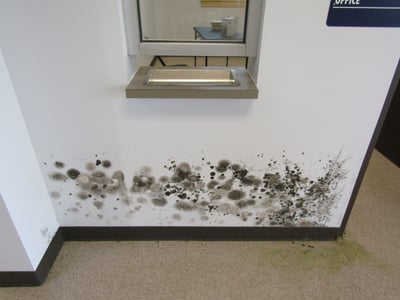
Vestibules are not required by code in warmer climates (ASHRAE Climate Zones 2 and below), but installing a vestibule can help control infiltration into the building in warmer climates, especially when wind is a contributing factor. Also, resist the urge to operate supply fans intermittently when the building is occupied. Doing so violates the building ventilation code and prevents the building from maintaining positive pressure.
HVAC Testing and Balancing
Make sure HVAC systems are appropriately sized, tested and balanced. HVAC systems rarely work perfectly immediately after installation. Projects should include a process for independent testing and balancing by NEBB or AABC certified contractors.
Independent Commissioning of Building Systems
Even better, provide for independent commissioning of building systems. These processes help to ensure that building systems are operating correctly per the intended design.
HVAC Supply Air
Make sure design supply air is reasonable for HVAC operating condition. Operating cooling equipment at airflows that are too low can cause supply discharge air temperatures to be very low, which can cause condensation to occur on interior building surfaces. Condensation on interior surfaces creates conditions that are favorable for mold growth.
HVAC hot gas reheat coils and dehumidification controls
Don't overcool the space. Although overcooling a space may seem like a good way to get more dehumidification performance out of the HVAC system, it only works up to a certain point.
Once the space temperature gets below the dew point temperature, any moisture in the air will start condensing on interior building surfaces, creating conditions that are favorable for mold growth. Provide hot gas reheat dehumidification and controls.
For projects utilizing packaged HVAC equipment such as rooftop units, most manufacturers now offer units with hot gas reheat coils and dehumidification controls. These systems work by overcooling the air to provide additional dehumidification, but then reheating the air with the waste heat from the refrigeration process to provide a reasonable supply air temperature.
Although there is a fan energy penalty due to existence of the hot gas reheat coil in the air stream, we strongly recommend this option for projects located in warm and humid climates. These systems are very effective at controlling interior space humidity conditions and provide excellent thermal comfort conditions while
avoiding the indoor conditions that are favorable for mold growth.
Demand-Controlled Ventilation for High Occupancy
Implement demand-controlled ventilation for space types that can have high occupancy. Demand-controlled ventilation utilizes CO2 sensors as a proxy for indoor air quality.
As CO2 builds up in the space, the building control system adjusts to provide more ventilation air into the space. However, spaces that can handle high occupant densities often operate at much lower occupant densities, and, thus, the code required ventilation can greatly exceed what is actually required to maintain reasonable indoor air quality.
Demand-controlled ventilation provides less ventilated air during those low occupancy times, saving energy while still providing appropriate ventilation to the space. Since the ventilation air in humid climates contains a lot of moisture, demand-controlled ventilation ensures that less moisture is being brought into the building through the ventilation system when there are fewer occupants in the building.
Implement condensate overflow safety switches
These simple low-cost safety switches prevent condensate drain pans from overflowing if the HVAC system condensate drainage system stops working. They operate by shutting down the cooling operation of the HVAC unit if the water level in the drain pan reaches a certain level.
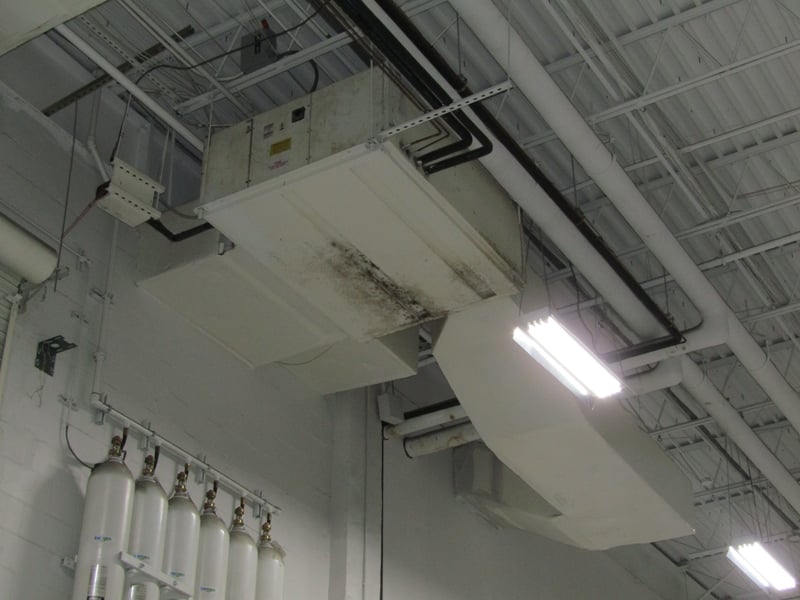
CONCLUSIONS
Moisture control is extremely important to creating safe and healthy environments in buildings located in hot and humid climates.
Having well-designed building envelopes helps to prevent moisture from entering buildings and control moisture once it does enter the building. Correctly designed HVAC systems play a large role in moisture control by providing dehumidification of moist air that enters the building.
There are many strategies that can be used to ensure that moisture is being controlled in the building including: periodic inspection of building envelope elements and HVAC systems; selecting appropriate HVAC options and accessories that reduce moisture loads and enhance dehumidification; and including independent test and balance work in projects to ensure proper HVAC equipment operation.
Let us help you engineer a better experience!

